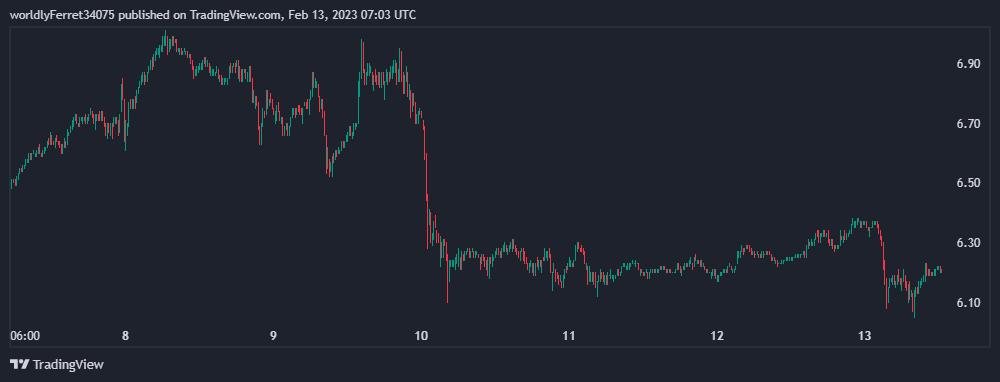- Polkadot ($DOT) price is down by almost 6% in recent one week.
- Last week, Polkadot shared a series of posts that gave a brief overview of Polkadot’s parachain.
Polkadot ($DOT) is currently trading at a price of $6.20 USD with an increase of around 0.32% in the last 24-hours. However it is down from one week by almost 6.63%. And its one-month price states that $DOT is up by almost 14.81%, according to the data sourced by Tradingview.

At press time, Polkadot has a market cap of $7.215 Billion, with a 24h trading volume of $241.795 Million.
Polkadot’s Parachains
Last week, Polkadot continued its series and celebrated the first year of parachains on its network. Polkadot shared a blog post that mentioned its move from decentralized finance (DeFi) to System Chains, Smart Contracts, and Social Media.
Along with the potential of Web3 to fuel innovation across a wide range of use cases, Polkadot’s ecosystem of parachains is buzzing with activity across DeFi, smart contracts, social media, decentralized identity, IoT, gaming, the metaverse, sustainability, and more. As Polkadot mentioned this year is shaping up to be the “biggest year yet for Web3 innovation.”
Polkadot firstly added about System parachains, previously known as Common Good parachains. This provides core functionality on a not-for-profit basis. As “Statemint provides basic asset functionality, allows any entity to deploy assets (including NFTs) & offers multi-asset functionality for a range of use cases.”
Additionally, the “Collectives parachain helps create groups like The Polkadot Fellowship, a decentralized group of Polkadot experts who play a key role in the network’s governance system.”
Another collective is the Polkadot Alliance, recognizing positive contributions to the ecosystem. This also “set a code of ethics around frauds, malicious behavior, misuse of the Polkadot brand, and unattributed code.”
In the first wave of Polkadot’s smart contract parachains, the network featured Moonbeam Network, Astar Network, and Acala Network. At present these are familiar projects which have won the first 3 auctions and drive a broad range of cross-chain, interoperable Web3 integrations.
Meanwhile, more smart contract parachains also emerged such as PhalaNetwork — decentralized cloud computing, Darwinia Network — cross-ecosystem bridging, Aventus Network — enterprise focus, inc. NFTs, and Watr Protocol — sustainable commodities.
Polkadot’s first two social media parachains are Frequency and SubsocialChain. These “chains seek to give users full control over their data and ownership of their “social graph” while allowing devs to build their own social networks on top of their tech.”
In the first blog from the “Year in Parachains” series, the Polkadot’s DeFi parachain landscape featured Acala Network, Parallel Finance, CLV, Composable Finance, Centrifuge, Interlay HQ, Equilibrium DeFi, Polkadex, Oak Network, & other teams.
At the end, Polkadot also mentioned about the next update that will look at parachains that support data, ID, privacy, storage, and infrastructure initiatives.
Disclaimer
The views and opinions stated by the author, or any people named in this article, are for informational ideas only, and they do not establish the financial, investment, or other advice. Investing in or trading stocks comes with a risk of financial loss.
Source: https://www.thecoinrepublic.com/2023/02/13/dot-price-analysis-and-a-brief-overview-of-polkadots-parachains/
